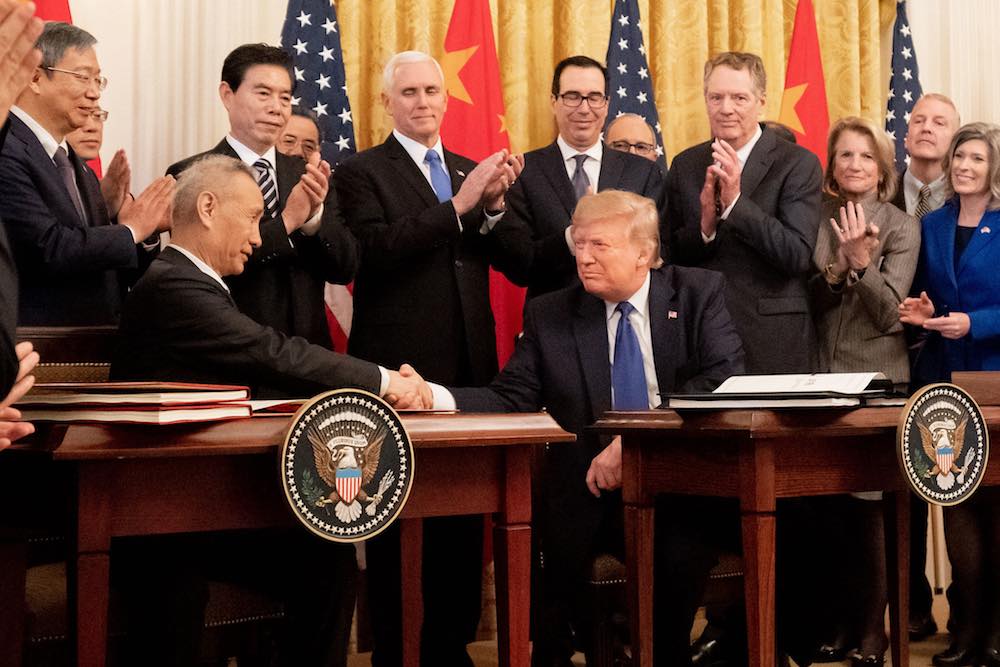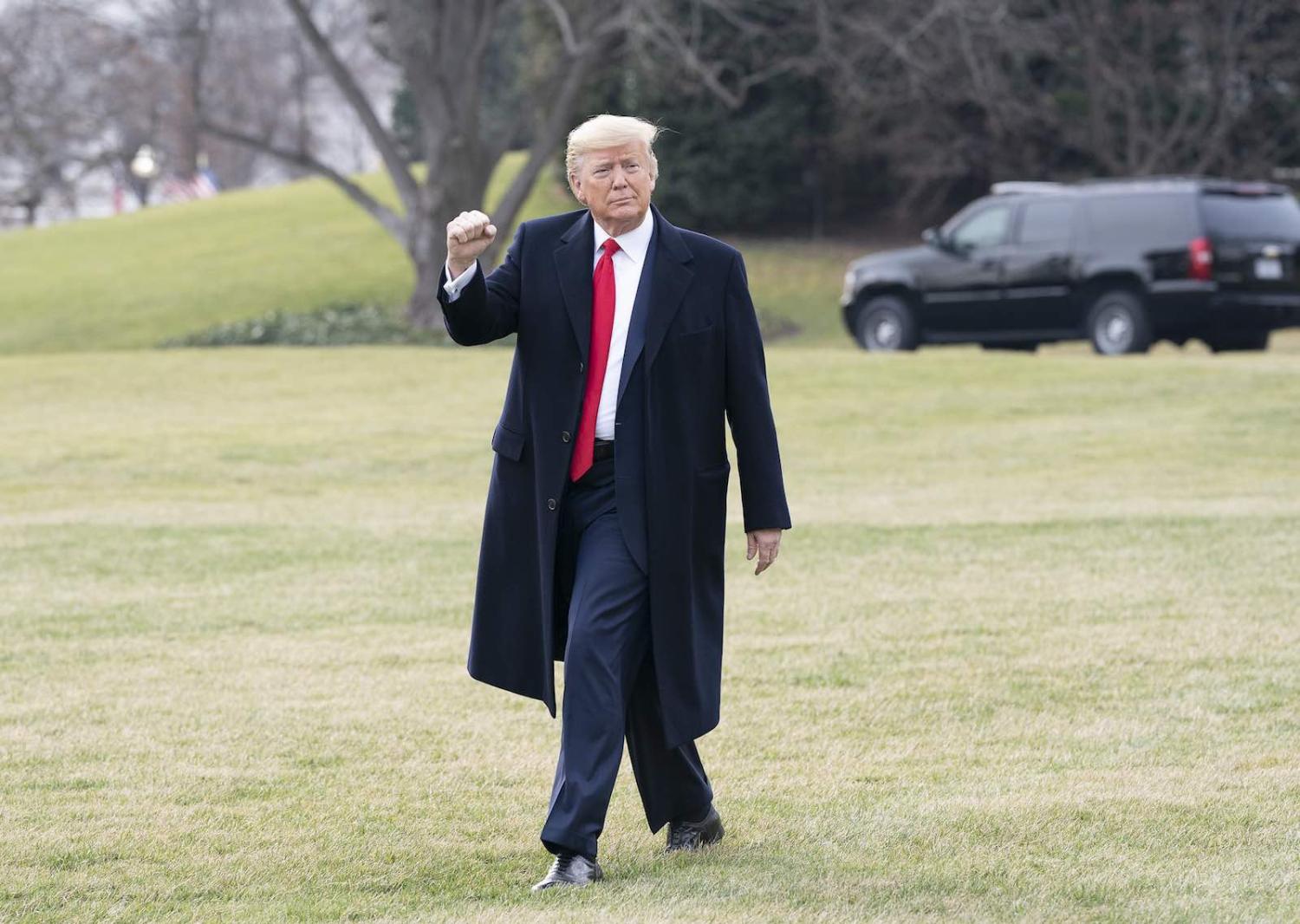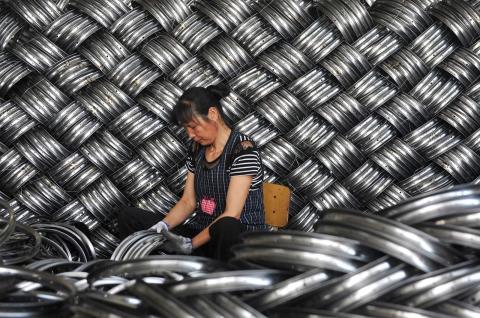US President Donald Trump was quite right when he declared the 15 January US–China “Stage One” agreement an “unbelievable deal” for the United States. Unbelievable it is, though not in a good way – and especially not for Australia.
The deal requires China to import $200 billion more from the US this year and next, compared to the baseline of China’s imports from the US in 2017. The arithmetic (see below) implies that China’s imports from the US this year must be 80% higher than its imports from the US last year.
That won’t be easy, and may well be impossible.
If China succeeds in doing so it will almost certainly be partly at the expense of other exporters to China. Europe is well aware of this, and has already threatened a World Trade Organisation dispute against China. Australia, too, should be wary of how this deal will play out, although Trade Minister Simon Birmingham seems unfussed.
Birmingham ought to be a little more bothered than he appears because the additional goods purchases from the US in 2020 to which China is now committed total more than the entirety of Australian goods exports to China in 2018, and not very much less than the entirety of Australian goods exports to China in 2019.
For Australia and other third countries with strong economic relationships with China, the only really good news in this agreement is that America is clearly not detaching from China.
Not only is the increase required equivalent to the total of Australian goods exports to China. It also covers many of the same products. Australia supplies 7% of China’s farm imports and 8% of its energy imports. The US is now the third biggest exporter of liquid natural gas after Australia and Qatar, and it has plenty of capacity. It is a big coal exporter. It exports liquid petroleum gas. It exports meat, dairy and wine. Iron ore is a big exception, but iron ore apart most the merchandise Australia otherwise sells to China competes with exports by the United States. Because iron ore exports account for well over a third of Australian goods exports to China, it follows that the total of Australia’s non-iron ore exports to China is much less than the addition to non-iron ore US goods exports to China required in 2020 under the new agreement.
Having admonished Australia (and Germany, Japan, and South Korea) for depending too much on the China market, the US is now elbowing Australia and other allies out of the way in a race for that same market.
The deal also includes China commitments on behind the border impediments to US farm exports, additional liberalisation of foreign investment in financial services, commitments on protection of intellectual property, and an undertaking to ban authorities seeking technology transfer to Chinese partners in joint ventures.
Many of these commitments were blessed at the National People’s Congress in March 2019, some already legislated, and some others are minor.
For Australia and other third countries with strong economic relationships with China, the only really good news in this agreement is that America is clearly not detaching from China.
The agreement goes in the opposite direction from decoupling. It increases the value of the Chinese export market to the US, and places no additional restriction on China’s exports to the US (compared for example to the 1981 US “voluntary restraint” auto agreement with Japan).
It also increases US direct investment access to the finance industry in China, and removes some impediments to deploying US intellectual property in China. It formalises dispute settling and consultation procedures.
All these understandings will tend to increase economic integration of the US and China. At his 15 January signing ceremony for the agreement, Trump promised that stage two of the negotiations would open up much more opportunities for US businesses to invest in China.
The stage one agreement itself reflects a change in the Trump administration’s declaratory posture towards the China US economic relationship. It includes a statement that:
The Parties believe that expanding trade is conducive to the improvement of their bilateral trade relationship, the optimal allocation of resources, economic restructuring, and sustainable economic development, given the high degree of complementarity in trade between them.
In respect of its two biggest national economies, together accounting for four tenths of global output, the trend towards global economic integration remains intact.

The arithmetic (all figures in US dollars)
- In the Stage One agreement China agreed to buy from the US an additional $76.7 billion in goods and services this year, and $123.3 billion in 2021. The baseline year is 2017, the peak year for China’s imports from the US.
- For goods (as opposed to services), the requirement is for an additional $64 billion in 2020, and $98 billion in 2021, for a total of $162 billion over the 2017 baseline.
- In 2017 US goods exports to China totalled $130 billion, according to the US Census Bureau. China has therefore committed to a minimum level of goods imports from the US of $194 billion in 2020, and $228 billion in 2021, to reach the total increase of $162 billion in goods imports over the 2017 baseline over two years.
- China’s goods imports from the US are likely to come in around $107 billion in 2019 (December 2019 data is not available until 5 February). If so, the increase required in 2020 over 2019 is $87 billion, or 81% over the 2019 level.
- The increase required is equivalent to around 4.4% of China’s total goods imports in 2018. For comparison, the value of Australian goods exports to China in 2018 was around $82 billion. For 2019 Australian goods export to China are likely to be worth around $101 billion.
- The goods increase required must be in farm products, energy and manufacturing and in the industry categories nominated in the agreement, though the categories are very wide. This appears to leave open the possibility that China could increase US imports in the nominated areas and decrease them in other areas. I assume that for obvious reasons that is not a practical possibility for China.

